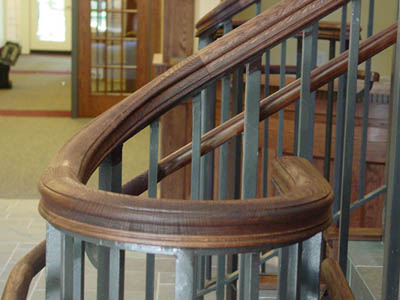Capping Metal Railing
Needless to say, but tangent handrailing is a very precise way of constructing the sections of rail on a curved staircase. Many times, metal railings are fabricated, and capped with wood grip rail. Communication is extremely important in situations where the metal is fabricated by a different shop than the wood segments, since mating of the two components is critical.  Planning and layout will go a long way toward successfully combining welded metal panels and wood railings.
Planning and layout will go a long way toward successfully combining welded metal panels and wood railings.
This is a place where 3D CAD models can really improve the success rate. A virtual model of each component will reveal every conflict and variance, allowing them to be resolved before the first cut is made. This virtually assures the proper mating of each piece, while preserving the smooth, graceful lines of the tangent handrail.
3D models are also superior representations for client approvals, adding a wow factor that gives your customers the comfort of knowing that you are up-to-date with modern technology. This can be an important factor in your client relationship.